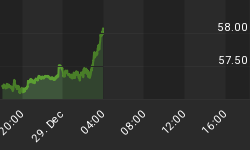In our 31st March commentary we discussed the errors we saw in Gary North's opinion that the Fed is deflating. Strangely, Mr. North took this as a personal attack and launched a personal counter-attack at http://www.garynorth.com/public/3328.cfm.
We didn't make any personal comments about Mr. North's analytical ability in our previous report -- we took issue with one aspect of his analysis, not with his overall analytical ability -- and won't do so now. In other words, we aren't going to respond in kind to the above-linked article. Instead, we'll simply point out some of the salient differences between his outlook and our outlook. Before we get started, though, the point we took issue with -- and rebutted -- in our previous report was his claim that the Fed was deflating. This needs to be kept firmly in mind, because in his attempt to rebut our rebuttal Mr. North makes liberal use of rhetoric in an apparent attempt to shift the reader's focus to other areas. To set the record straight we will touch on some of these other areas in the following discussion while trying to stay as close as possible to the original topic.
The first thing we'll note is that when we use the term "inflation" we mean an increase in the total supply of money. Therefore, if the total supply of money is increasing then, as per the definition we use, inflation is occurring. There is a reasonable difference of opinion as to which monetary aggregate best represents the inflation (money-supply growth) rate, but for the reasons outlined in our earlier discussion on this topic and briefly addressed below we are certain that M1 is amongst the poorest representatives of the true inflation rate.
Secondly, Mr. North appears to believe that the CPI is a good indicator of the effects of inflation (what he calls "price inflation")*. Our view, however, is that the CPI is a number concocted by the government primarily for the purpose of managing inflation expectations and these days bears little resemblance to the loss of purchasing power that is actually occurring within the economy. Evidence supporting our view is provided by the large difference between the pre-Clinton CPI and the current version of the CPI as illustrated by John Williams at http://www.shadowstats.com/.
Thirdly, Mr. North cites the recent downturn in the gold price as evidence that his deflation claim was 'on the mark', but a sharp bull-market correction in gold does not constitute evidence that the Fed is deflating. For one thing, we know that the Fed is NOT causing deflation since the total supply of money has been rising. For another thing, there is no consistent relationship between short-term movements in the gold price and changes in either narrow or broad money supply. For example, M1 is roughly the same today as it was three years ago, yet the gold price has more than doubled during the intervening period.
Fourthly and as explained in our previous piece, M1 has generally been a poor indicator of monetary conditions since the early 1990s thanks to the regulatory changes that were implemented at that time. M1 now tends to remain flat for many years at a time, as it has been since the final quarter of 2004.
Finally, we all know that markets don't move up or down for extended periods in straight lines. Even when the fundamentals decisively point one way, a market will often move in the opposite direction for a while before returning to its underlying trend. Prior to the start of gold's correction there were, according to Market Vane, more than 10 gold bulls in the speculating community for every gold bear, and whenever sentiment becomes that lopsidedly optimistic the risk of a sharp pullback will always be high.
Of course, it wasn't just the gold market that was at risk of a sharp correction due to extremely lopsided sentiment. In our 5th March commentary, under the heading "Commodity Reversal Imminent", we wrote that "the Continuous Commodity Index (CCI) was embroiled in an upside blow-off that should lead to an intermediate-term peak within the coming few weeks (probably by mid March and almost certainly by early April). Food commodities have been leading the charge higher and, as a result, will probably experience the largest price declines once a trend reversal occurs.
Bull markets are fueled by the conversion of sceptics (bears) to believers (bulls), which is why they tend to end, or at least experience substantial corrections, shortly after the proportion of bearish market participants has fallen to a low percentage. According to Market Vane, earlier this week only 2% of traders were bearish on soybean oil, only 3% of traders were bearish on oats, only 4% of traders were bearish on soybeans, only 6% of traders were bearish on cocoa, and only 10% of traders were bearish on corn. The world of precious metals is almost as one-sided with only 5% and 7%, respectively, of traders bearish on gold and silver. The other side of the coin is that about 80% of traders are bearish on the US$."
Further to the above, the catalyst for the recent gold correction was most definitely NOT a Fed-driven tightening of monetary conditions (how could it have been when such a tightening never occurred?), but was, instead, largely a consequence of the extreme bullish sentiment that led to the build-up of a massive speculative long position in gold futures. Other factors that played significant roles were: a) the stabilisation and subsequent rebounding of the broad stock market (as anticipated in our commentaries), b) the temporary narrowing of credit spreads, and c) a rebound in the US$ relative to the euro.
*"Price inflation" is a term we always avoid because it strictly means more prices, not higher prices, and confuses the cause (inflation) with ONE of the effects (higher prices).
















